Workload Management for Agencies
Agency life isn't always sunshine and rainbows. Client requests come in left and right, you're managing a growing remote team and you're trying to do the business side of things too.
And in this fast-paced world of agency life, project management serves as your orchestrator, coordinating the efforts of your team to achieve outstanding results and success for your clients.
Hiring skilled project and account managers is a big step in any agency journey, but for them to be effective and help create a super productive team (that's NOT burnt out), you need to be able to effectively manage workload.
Workload-Driven Project Management provides a three power balance - Demand, Resources, and Fulfillment - to plan, allocate and prioritize resources efficiently and effectively.
By understanding and implementing this methodology, agencies can better forecast work, boost productivity, improve utilization and exceed client expectations.
So if you're ready to take the chaos out of project management at your agency, keep reading...
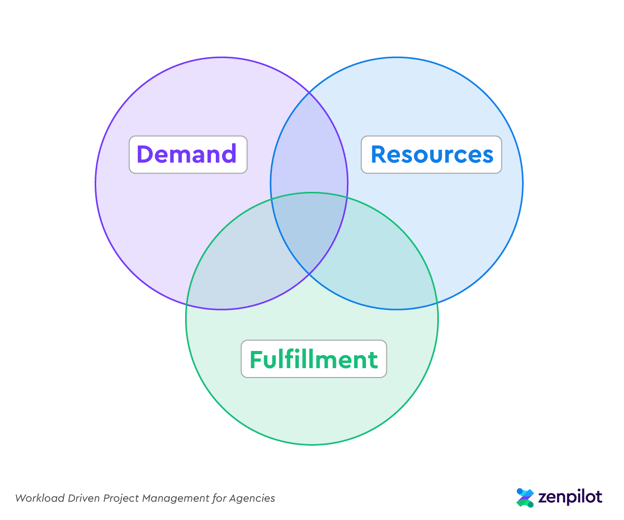
Before you read on..
Take the Agency Project Management Benchmark Assessment to see how your operations stack up against 3,000+ other agencies.
The Agency Power Balances: Demand, Resources, and Fulfillment
To achieve sustainable growth and success, it's crucial to strike a balance between Demand, Resources, and Fulfillment.
But what do these elements mean and who occupies each role?
- Demand - This element represents the client's requirements and/or what needs to be accomplished. This involves account managers who interact with clients, understand their expectations, strategize plans for upcoming projects and deploy tasks.
- Resources - This element pertains to the time and place where a project will be executed. This involves project managers ensuring that the expectations set by the account managers are synchronized across various teams, scheduled accordingly and tasks are assigned.
- Fulfillment - This element is the actual execution of tasks. Whether by full-time employees, part-time contractors, or even partner agencies, this is where promises made to clients are completed and kept.
Demand determines what we're going to do (and why were going to do it), Resources determine how we're going to do it, and Fulfillment get's it done.
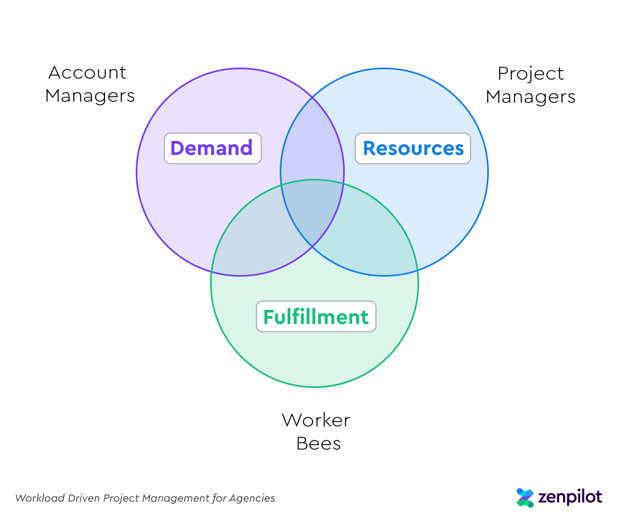
When all three work in harmony you deliver on time, in budget and everyone is happy.
But if harmony is lost, you begin over or under delivering for clients, over or under utilizing team members and hurting productivity and profitability.
The concept of Workload-Driven Project Management isn't rocket science, but it does require organization, accountability and leadership.
Let's break this concept down in more detail and discuss how they can all best work together to help you implement at your agency today.
Turn Chaos Into Clarity.
We're your agency operations pilot.
You can build a happier, more productive, more profitable team with ClickUp. We'll show you how.
Understanding Demand
What Does the Demand Role Do?
The person in the Demand role is responsible for being the main point of contact with clients, understanding their goals, and coordinating the connection of strategy to reality.
They take leadership in:
- Reporting results to clients, revising strategies as needed, and deploying and configuring templates (tasks) to accomplish goals within agreed timelines.
- Balancing client requests with budgets and monitoring external costs and internal resources.
- Bringing clients back to reality by discussing budgets - points, hours, or dollars - with them and prioritizing what needs to be done. Yes, sometimes you need to say "no".
- Working alongside Resources and Fulfillment to ensure that client work is delivered on-time and on-brief.
- Working closely with Resources to keep client expectations in line and prevent fires.
- Providing context with the Fulfillment team to get tasks done right the first time.
Who Should Fill the Demand Role?
The best case scenario for agencies is to have dedicated Account Managers to fill this role.
However, this role can also be filled by:
- Team representatives depending on the type of project/service line.
- A POD lead that is a consistent point of contact for clients but also sits in the Resource seat.
- Or a lead strategist who leads the client relationship but also fills some of the Fulfillment seats for clients.
Regardless of who fills this seat, the most successful agencies have one person managing the client relationship to ensure there is accountability, simplicity for the client, and always context into the work being done.
Understanding Resources
What Does the Resources Role Do?
At a high level, the person in the Resources role is responsible for managing workload and making capacity driven decision to assign work while monitoring timelines.
They take leadership in:
- Forecasting and scheduling work while holding the team accountable on due dates.
- Looking ahead to identify resourcing gaps in Fulfillment.
- Monitoring and managing task statuses to keep projects moving.
- Following up on tasks that continue to be rescheduled without context.
- Working with Fulfillment to prioritize work assignments.
- Communicating with Demand when projects need to be remapped from delays or shifting priorities.
Who Should Fill the Resources Role?
The best scenario for agencies is that they have dedicated Project Managers fill this role.
For larger agencies, you may have dedicated Project Managers who coordinate with Team Leads. Team Leads may make the final call on assignments based on their teams skill and bandwidth, but often times Team Leads trust the Project Managers to assign work. Both of these scenarios work as long as there is standardized across the team.
However, in some agencies this seat can be filled by:
- Team or Department leads
- Account Managers who cover both Demand and Fulfillment
- Lead Strategist who wears a ton of different hats (common for smaller agencies)
Your Teamwork or ClickUp Champion will come from Resources. They are in charge of monitoring and managing the system - holding the team accountable and keeping your PM system clean, organized and matching reality.
Understanding Fulfillment
What Does the Fulfillment Role Do?
The Fulfillment role is responsible for completing (with flying colors) the work assigned to them.
It sounds simple, doesn't it?
It is, until they are assigned tasks without context, instruction or due date. Hence the need for proper balance amongst the three roles.
This is where a lot of agencies struggle.
Agencies can often put together a killer strategy and timeline, but they don't have the processes and systems in order to execute on that plan.
Every task is important. Everything takes time. And time is valuable.
Who Should Fill the Fulfillment Role?
The Fulfillment role can be filled by full-time employees, part-time contractors, or even partner agencies.
Pro Tip - you'll want to build Delivery Roles into your process templates within your project management platform. These Delivery Roles will help determine who will be assigned to a particular task.
Now, let's dive into to how these roles can work together in harmony.
The Push and Pull: Creating a Harmonious Balance
Establishing harmony amongst Demand, Resources, and Fulfillment requires constant 'push and pull' between roles.
It involves sharing work requests, formulating realistic timelines, assigning tasks, deciding priorities, gathering context, and delivering quality results promptly.
Demand and Resources
Between Demand and Resources, there is a constant exchange of work requests and feedback regarding the feasibility of timelines.
The account managers communicate the client's needs, and the project managers respond with timelines that align with the available resources.
Account managers may push work and a deadline that isn't manageable. Project managers need to push back, provide realistic expectations and/or pull in additional resources if possible and necessary.
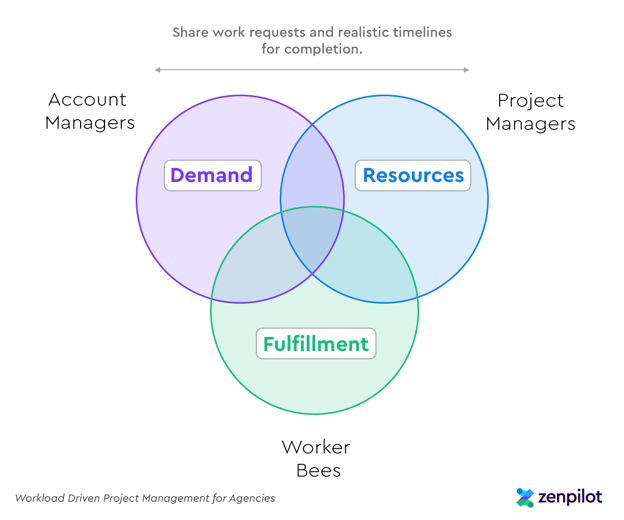
Resources and Fulfillment
Similarly, between Resources and Fulfillment, there's an active dialogue involving task assignments and timeline negotiations.
Project managers orchestrate the entire task load, managing workloads, coordinating between projects, and ensuring the right person is assigned the right job.
They communicate with team leads to identify suitable candidates and delegate tasks.
If there are any adjustments needed due to delays or other hitches, the project managers address those dynamically.
As projects are launched and actively worked on, it may be necessary for Fulfillment to push due dates or reassign tasks to other team members. Effective communication amongst Resources and Fulfillment is crucial to ensure that progress continues smoothly.
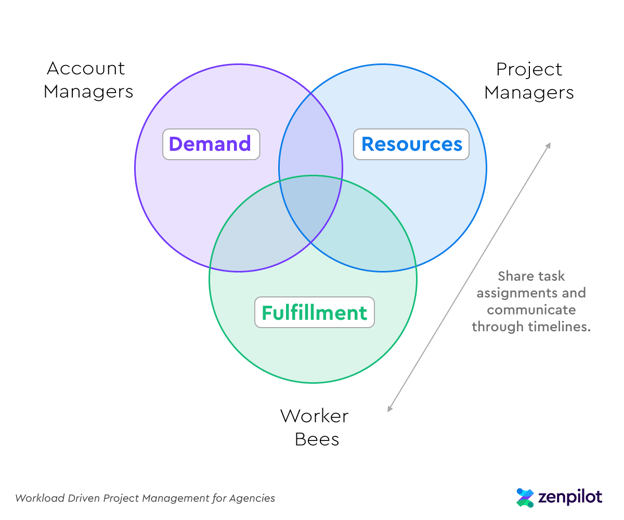
Demand and Fulfillment
Lastly, the interaction between Demand and Fulfillment revolves around context.
- What does the client desire?
- What is their vision of the end product?
- What does a quality deliverable look and feel like?
It involves account managers providing context around deliverables for fulfillment to create things right the first time and knock every project out of the park.
It's important to clarify the client's expectations right out of the gate to avoid time-consuming revisions later.
Healthy communication between Demand and Fulfillment ensures that no task is assigned out without any context or instruction - improving productivity and quality of work.

Improving Agency Operations With Workload-Driven Management
In summary, Demand, Resources and Fulfillment all work together in harmony to help clients reach their goals.
To achieve this goal, they have their core responsibilities:
- Demand deploy tasks
- Resources assign tasks
- Fulfillment complete tasks
And they have shared responsibilities:
- Demand + Resources determine delivery standards to meet client expectations within budgets.
- Resources + Fulfillment communicate and define workload balance to maximize utilization of the team and identify potential bottlenecks.
- Demand + Fulfillment identify and document client expectations for deliverables and timelines.
And all are working to create a continuous delivery flow of a streamlined strategy, timeline and execution.
Deploy tasks → assign tasks → complete tasks → document findings and improvement opportunities → optimize process templates → repeat
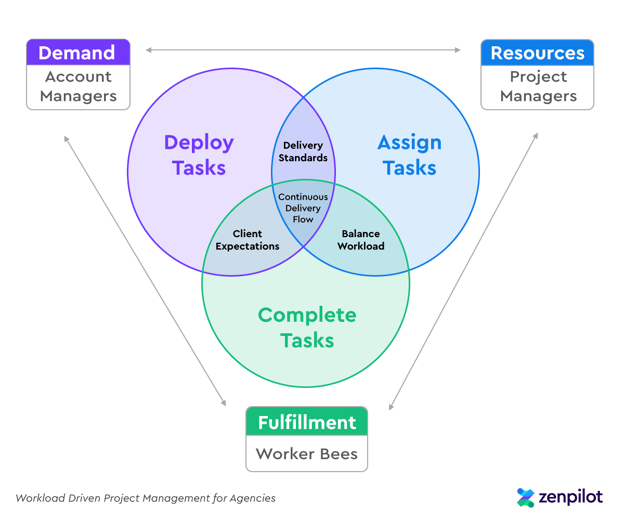
Are You Ready to Take The Chaos Out of Project Management?
Implementing Workload-Driven Project Management takes time, leadership and accountability. Though it's not a light switch that can be turned on, the best time to start building the foundation is today.
We've seen agencies increase productivity by over 400%, increase client LTV by over 46%, significantly improve client NPS, and boost utilization by 27% in just a few months.
Agency life doesn't have to be chaotic.
Imagine a world where your team has a list of tasks with context and instructions every morning, your account managers aren't over promising, project managers can actually see workload, and your clients want to pay you more and more money because you're consistently exceeding their expectations.
We want you to experience this life changing impact.
If you're ready to enjoy the power of gold-standard operations, schedule your free ops strategy call here.
Take the Guesswork Out of Agency Profitability and Utilization
Stop making decisions with guesstimates. Get a glimpse into your agency's profitability and utilization.
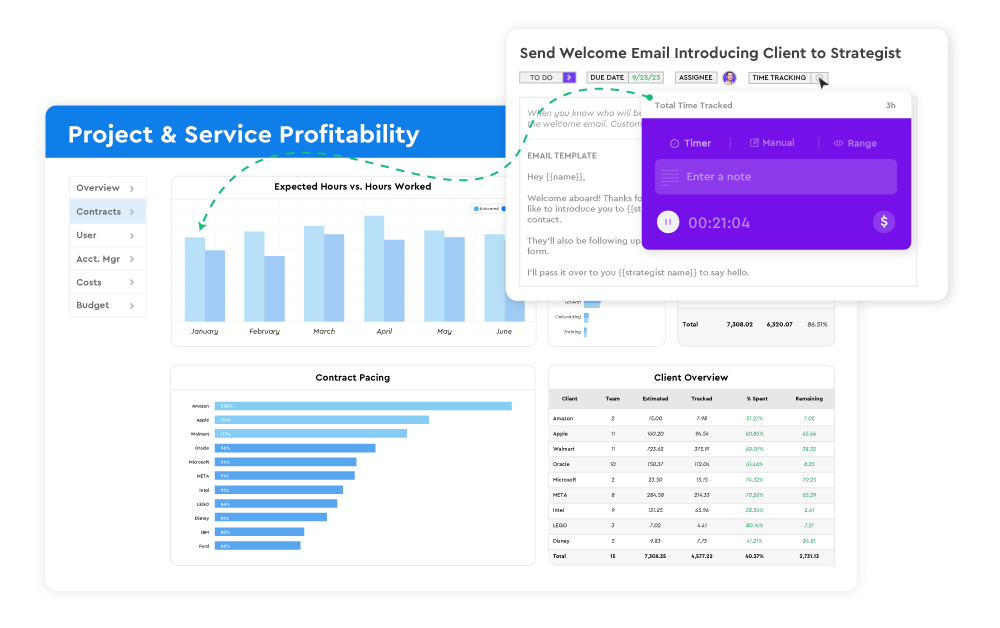
Frequently Asked Questions
How can project managers best see and manage workload for their fulfillment team?
Most project management tools come with a workload view. Teamwork's workload view and ClickUp's workload view are great.
But these are meaningless without having due dates, time estimates and assignees on every task.
If you want your project managers to have any visibility into workload for planning purposes, you need to start there. Build your processes with time estimates, due dates and delivery roles (which will eventually turn in to assignees).
Additionally, you need take OOO in to consideration. Make sure this is reflected in your project management tool so that your project managers can reassign work when necessary.
Lastly, you'll want to set up daily capacities for users in both Teamwork and ClickUp.
All of these steps will make workload more realistic and help project management provide realistic timelines to account management.
Where can the team see their workload, track time and complete tasks?
Every user in your system should have a filtered "My Tasks" list. This will show them tasks that are overdue, due today and in the future.
They can work through this list throughout the day and track time, close tasks and communicate all in one place.
And if you've built process templates with detailed instructions and/or checklist into all of your tasks, your Fulfillment team will have everything they need to complete a task, inside of the task.
As we always say, "The process lives where the work get's done."
Where should account managers provide context and task instructions for the fulfillment team?
Your project management tool should be the single source of truth. Communication needs to happen inside your pm tool.
Account managers should be providing context directly in the tasks themselves for Fulfillment to see. This gives Fulfillment the ability to focus less on finding information and more on completing work.
Additionally, if using Teamwork or ClickUp, we recommend that your account managers take meeting notes inside of your PM system. This will create a central location for everyone to be able to see what was discussed.
You can learn more about this by watching our video, "How Agencies Need to Communicate Inside of ClickUp to Deliver Stellar Client Results".
How can our agency get better at forecasting?
Forecasting takes time and effort. We recommend that you document and measure three ratios in your project management tool to improve performance - compliance, completed and velocity.
Each of these collectively will help you understand how good your team is at planning and execution inside your project management tool.
You can read more about these ratios and how to improve forecasting in our post, "Three Project Management Metrics Agencies Need to Measure".
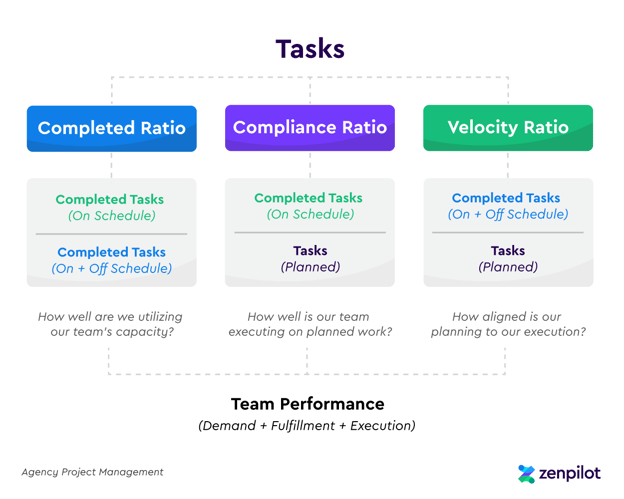
What are some ways to improve team collaboration and communication inside of our project management platform?
There are 3 communication best practices you'll want to implement at your agency to ensure information flows smoothly across your team.
1. Account management weekly updates
2. Centralizing client documents and notes
3. And centralizing team collaboration in parent tasks
All three will help your team work together and make sure everyone is well aware with what's happening and how they can help.




